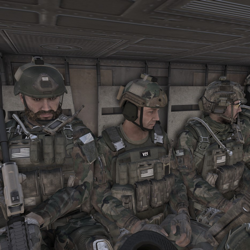Tablet
Overview
 For a Platoon Leader to be effective, they must have a good tactical overview of what is happening in the air and on the ground. The Commander's Tablet and associated devices are provided to specific personnel such as Corpsmen, Squad and Fireteam Leaders. This allows them to see key information on the battlefield such as friendly positions, FOBs, casualty centers and even reports of hostile activity.
For a Platoon Leader to be effective, they must have a good tactical overview of what is happening in the air and on the ground. The Commander's Tablet and associated devices are provided to specific personnel such as Corpsmen, Squad and Fireteam Leaders. This allows them to see key information on the battlefield such as friendly positions, FOBs, casualty centers and even reports of hostile activity.
Devices
A number of devices are provided to personnel in order to provide a complete overview of the battlefield.
- The Commander's Tablet is issued to the Platoon Leader and Joint Terminal Attack Controller and allows them to view and set markers, send and receive messages, and view live camera feeds. With this device they are able to coordinate ground and air assets as necessary in order to complete the objectives assigned to them.
- The GD300 Android is a smaller device provided to Squad Leaders and Radio Transmitter Operators. This device allows them to view and set markers with Platoon and other Squads, as well as send and receive messages. The GD300 Android is not capable of viewing camera feeds.
- The MicroDAGR, not to be confused with the MicroDAGR Radio Programmer is used by Fireteam Leaders to see markers placed by Platoon or Squad.
- The Helmet Camera is provided to Squad and Fireteam Leaders, allowing the Platoon Leader to see a live camera feed from the wearer's helmet.
Map Markers
Map Marking is an important feature of the Commander's Tablet and GD300 Android. It allows elements to provide precise positions for observations already communicated via Radio, giving Platoon and Squad Leaders an accurate overview of the battlefield. The following list explains the available marker types:
- Enemy is for marking an enemy position, including type of unit, size and direction of movement.
- Logsitics is a category of multiple markers related to Platoon management.
- VRP (Vehicle Resupply Point) marks a location where vehicle assets can receive repair and resupply.
- CCP (Casualty Collection Point) marks a position where wounded can be collected for treatment.
- BAS (Battalion Aid Station) shows the location of a field hospital where seriously wounded can be taken.
- HQ (Headquarters) shows the location of a Headquarters building or Forward Operating Base.
- General is a category of generic markers for navigation or mission planning.
- MKR (Marker) is a generic marker useful for a variety of purposes.
- WP (Waypoint) marks a point used by a unit for navigation along a specific route.
- LZ (Landing Zone) designates the location of a desired helicopter landing zone.
- DZ (Drop Zone) can show the desired drop-off point for vehicular transportation.
- OBJ (Objective) is used for designated a location as an objective.
- WRN (Warning) is a multi-purpose marker for indicating a non-combatant threat (e.g. IED).
Message System
Both the Commander's Tablet and GD300 Android device feature an SMS messaging system. This offers units an alternative line of communication in case Radio is restricted, unavailable or otherwise incapacitated. It may also be used for sending non-essential messages when Longwave Radio channels are otherwise occupied with important communications.
Camera Feeds
The Commander's Tablet allows Platoon Leaders to get live camera feeds from a couple of different sources. The primary camera feed available is from units equipped with a Helmet Camera. This allows the Platoon Leader to see exactly what is occuring on the front line at any time. If a UAV is in operation, the Platoon Leader can also view a live camera feed from the craft, allowing them to get a live overview of the battlefield and better coordinate subordinate units when completing objectives.
